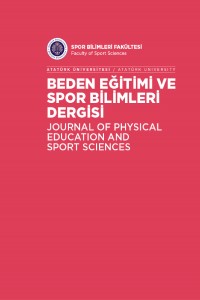Abstract
Bu araştırmada tenis sporuyla ilgilenen bireylerin hangi zeka türlerinin daha gelişmiş olduğunun belirlenmesi ve demografik değişkenler açısından incelenmesi amaçlanmıştır.
Araştırmanın evrenini İstanbul’da tenis turnuvalarıına katılım gösteren 159 (%48,5) kadın, 169 (%51,5) erkek olmak üzere toplam 328 tenisçi oluşturmaktadır. Araştırmada Mc Clellan ve Conti (2008) tarafından geliştirilen, Babacan ve Dilci (2012) tarafından Türkçe ’ye uyarlanan Çoklu Zeka Ölçeği kullanılmıştır. Araştırma istatistiğinde; verilerin normal dağılım göstermeleri nedeni ile parametrik testler olan bağımsız örnekler t-testi , ANOVA zeka türleri alt boyutlar içinde korelasyon analizi kullanılmıştır, ayrıca kişisel özellikler frekans ve yüzde değerleri analiz edilmiştir (α=0,05).
Araştırma bulgularına göre; sporcuların cinsiyet değişkenine göre yapılan karşılaştırmada ölçeğin müziksel zeka alt boyutunda anlamlı farklılık tespit edilmiştir (t=-2.202, p=.028, p<0.05). Yaşa göre yapılan karşılaştırmada ölçeğin kişilerarası zeka (F=3.493, p=.016, p<0.05), doğacı zeka (F=3.634, p=.013, p<0.05) ve sözel zeka (F=3.261, p=.022, p<0.05) alt boyutlarında anlamlı farklılık olduğu görülmüştür. Sporcuların yaşadıkları yere göre yapılan karşılaştırmada ölçeğin bedensel zeka (t=-2.692, p=.008, p<0.05) ve sözel zeka (t=-2.727, p=.007, p<0.05) alt boyutlarında anlamlı farklılık olduğu belirlenmiştir. Sosyal aktivitelere katılma durumuna göre yapılan karşılaştırmada ölçeğin içsel zeka (t=-2.779, p=.006, p<0.05) ve sözel zeka (t=2.065, p=.040, p<0.05) alt boyutlarında anlamlı farklılık tespit edilmiştir. Sporcuların branşla ilgilenme amaçlarına göre yapılan karşılaştırmada ölçeğin bedensel zeka (F=3.624, p=.013, p<0.05), içsel zeka (F=9.775, p=.000, p<0.05) ve mantıksal zeka (F=6.946, p=.000, p<0.05) alt boyutlarında anlamlı farklılık olduğu görülmüştür. Sporcuların tenis branşıyla ilgilenme sürelerine göre yapılan karşılaştırmada istatistiksel olarak bir fark görülmemiştir (p>0.05).
Sonuç olarak tenis sporuyla ilgilenen katılımcıların demografik özellikleri ile zeka türleri arasında anlamlı ilişkiler ve farklılıklar tespit edilmiştir.
Keywords
References
- 13. Köksal, M. S. (2006). Kavram öğretimi ve çoklu zekâ teorisi. astamonu Eğitim Dergisi, 14(2), 473-480.
Abstract
In this study, it was aimed to determine which intelligence types of individuals interested in tennis sport are more developed and to examine them in terms of demographic variables. The universe of the research consists of a total of 328 tennis players, 159 (48.5%) women and 169 (51.5%) men, who participated in tennis tournaments in Istanbul. Multiple Intelligence Scale developed by Mc Clellan and Conti (2008) and adapted to Turkish by Babacan and Dilci (2012) was used in the study. In research statistics; Due to the normal distribution of the data, independent samples t-test, which are parametric tests, correlation analysis among the ANOVA intelligence types sub-dimensions were used, and the frequency and percentage values of personal characteristics were analyzed (α = 0.05).
According to the research findings; In the comparison made according to the gender variable of the athletes, a significant difference was found in the musical intelligence sub-dimension of the scale (t = -2.202, p = .028, p <0.05). In the comparison made according to age, interpersonal intelligence (F = 3.493, p = .016, p <0.05), naturalistic intelligence (F = 3.634, p = .013, p <0.05) and verbal intelligence (F = 3.261, p = .022) , p <0.05) sub-dimensions were found to be significantly different. In the comparison made according to where the athletes live, it was determined that there is a significant difference in the physical intelligence (t = -2.692, p = .008, p <0.05) and verbal intelligence (t = -2.727, p = .007, p <0.05) sub-dimensions of the scale. In the comparison made according to participation in social activities, a significant difference was found in the internal intelligence (t = -2.779, p = .006, p <0.05) and verbal intelligence (t = 2.065, p = .040, p <0.05) sub-dimensions of the scale. In the comparison made according to the purpose of the athletes to be interested in the branch, the scale's physical intelligence (F = 3.624, p = .013, p <0.05), internal intelligence (F = 9.775, p = .000, p <0.05) and logical intelligence (F = 6.946, p = .000, p <0.05) sub-dimensions were found to be significantly different. It was determined that there was no statistically significant difference in the comparison made according to the duration of the athletes' interest in tennis (p> 0.05).
As a result, significant relationships and differences between the demographic characteristics and intelligence types of the participants who are interested in tennis sports have been determined.
Keywords
References
- 13. Köksal, M. S. (2006). Kavram öğretimi ve çoklu zekâ teorisi. astamonu Eğitim Dergisi, 14(2), 473-480.
Details
| Primary Language | Turkish |
|---|---|
| Subjects | Sports Medicine |
| Journal Section | Makaleler |
| Authors | |
| Publication Date | June 30, 2021 |
| Acceptance Date | June 24, 2021 |
| Published in Issue | Year 2021 Volume: 23 Issue: 2 |


